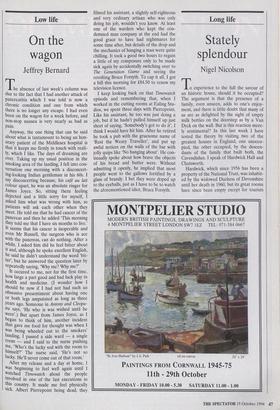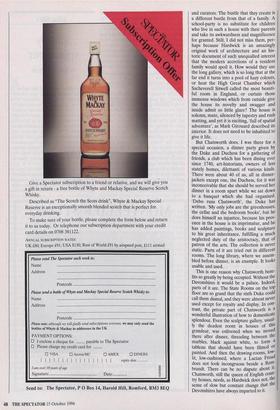Long life
Stately splendour
Nigel Nicolson
Hardwick, which since 1956 has been a property of the National Trust, was inhabit- ed by the widowed Duchess of Devonshire until her death in 1960, but its great rooms have since been empty except for tourists and curators. The bustle that they create is a different bustle from that of a family. A school-party is no substitute for children who live in such a house with their parents and take its awkwardness and magnificence for granted. Still, I did not miss them, per- haps because Hardwick is an amazingly original work of architecture and an his- toric document of such unequalled interest that the modern accretions of a resident family would spoil it. How would they use the long gallery, which is so long that at the far end it turns into a pool of hazy colours, or heat the High Great Chamber which Sacheverell Sitwell called the most beauti- ful room in England, or curtain those immense windows which from outside give the house its novelty and swagger and inside admit so little glare? The house is solemn, mute, silenced by tapestry and rush matting, and yet it is exciting, 'full of spatial adventure', as Mark Girouard described its interior. It does not need to be inhabited to give it life.
But Chatsworth does. I was there for a special occasion, a dinner party given by the Duke and Duchess for a gathering of friends, a club which has been dining ever since 1740, art-historians, owners of less stately homes, dilettanti of various kinds. There were about 40 of us, all in dinner- jackets except one, the Duchess, for it was inconceivable that she should be served her dinner in a room apart while we sat down to a banquet which she had organised. 'Debo runs Chatsworth', the Duke has written. 'My only jobs are the greenhouses, the cellar and the bedroom books', but he does himself an injustice, because his pres- ence in the house is its imprimatur, and he has added paintings, books and sculpture to his great inheritance, fulfilling a much neglected duty of the aristocracy, that of patron of the arts, The collection is never static. Parts of it are tried out in different rooms. The long library, where we assem- bled before dinner, is an example. It looks usable and used.
This is one reason why Chatsworth bene- fits so greatly by being occupied. Without the Devonshires it would be a palace. Indeed, parts of it are. The State Rooms on the top floor are so grand that the sixth Duke could call them dismal, and they were almost never used except for royalty and display. In con- trast, the private part of Chatsworth is a wonderful illustration of how to domesticate splendour. Even the sculpture gallery, usual- ly the deadest room in houses of this grandeur, was enlivened when we moved there after dinner, threading between the marbles, black against white, to form a tableau that should have been filmed or painted. And then the drawing-rooms, low- . lit, low-cushioned, where a Lucian Freud does not look incongruous beside a Rem- brandt. There can be no dispute about Chatsworth, still the queen of English coun- try houses, needs, as Hardwick does not, the sense of slow but constant change that the Devonshires have always imparted to it.



























































 Previous page
Previous page